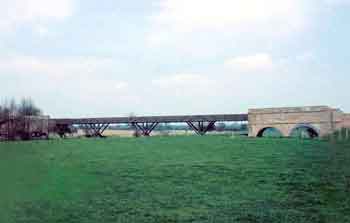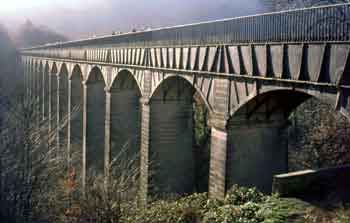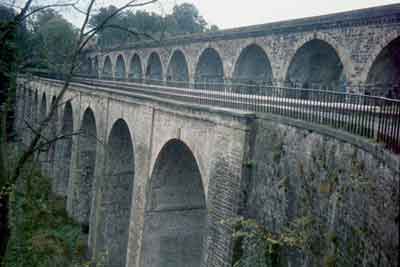
During construction of the Shrewsbury Canal the difficulty of crossing the river Tern at Longdon-on-Tern, Shropshire, had to be overcome. It was decided to construct a traditional masonry aqueduct but before completion heavy flooding washed it away.
 Thomas Telford.
Thomas Telford.The civil engineer Thomas Telford (9 Aug 1757-2 Sep 1834) designed a replacement for it but this time it was to be constructed of cast iron. The trough was to be formed from cast-iron plates fastened together with wrought iron nuts and bolts. The plates were flanged to increase their strength and facilitate fastening them together. The side plates were wedge-shaped, in the manner of voussoirs in a masonry arch. The trough was designed to be narrow, so boats were unable to pass, and the towpath was cantilevered outwards. The completed aqueduct is 186-feet long and it was laid along the top of three fabricated cast-iron supports and on brick and masonry abutments at each end. The four spans were 46 feet 6 inches long and the abutments were the remains of the earlier masonry aqueduct that was washed away. The aqueduct remained in water until the 1950s and it still stands as a lasting monument to Thomas Telford.
It is now accepted that Telford used this aqueduct as the prototype for the massive Pontcysyllte Aqueduct, which was needed to carry the Llangollen Canal (formerly the Ellesmere Canal) over the wide valley of the river Dee at Ruabon, near Wrexham, North Wales. The Longdon-on-Tern Aqueduct opened one month after Benjamin Outram's cast-iron Holmes Aqueduct on the Derby Canal in Derby, which opened in Mar 1796.
Telford must have noted that considerable effort was required to haul a boat along the trough of the Longdon-on-Tern Aqueduct, as it was difficult for displaced water to pass between the sides and bottom of the boat and the trough itself. As a result, on the Pontcysyllte Aqueduct the trough was made wider and the towpath was cantilevered inwards over the water. However, the trough was insufficiently wide for boats to pass.


In order to cross the Dee valley, Telford constructed 18 stone piers, firmly embedded in sandstone rock, and the fabricated trough was laid along the top of these. Like the Tern Aqueduct, the side plates were wedge-shaped, in the manner of voussoirs in a masonry arch. The cast-iron plates were manufactured at the Ketley ironworks of William Reynolds. The aqueduct is over 1,000 feet long, the trough is 11 feet 10 inches wide and it stands around 120 feet above the river Dee. It took 10 years to construct and it opened in 1805.
This large compound aqueduct was built by Thomas Telford and William Jessop and it opened in 1801. It carries the Llangollen Canal over the river Ceiriog at Chirk, which is situated to the south of Ruabon. It is 710 feet long with 10 spans and it stands 70 feet above the river. Although the aqueduct is of masonry construction, the water is carried in a cast-iron trough.

Listing
Longdon-on-Tern Aqueduct:Listed Grade I, List Entry No. 1037006.
Pontcysyllte Aqueduct:Listed as a World Heritage Site, List Entry No. 1000106.
Chirk Aqueduct:Listed II*, List Entry No. 1295150. Also part of the Pontcysyllte Aqueduct World Heritage Site.